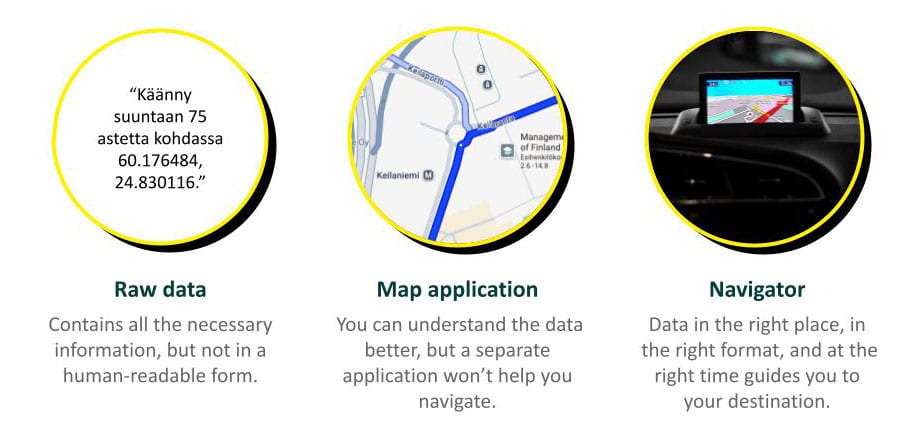Any company using Salesforce should consider purchasing Tableau Next to complement their current BI solution. Tableau's latest version offers benefits not available with other solutions, putting the data in front of the end user.
Many of us remember a time before car navigators. When you needed to find your way to a new address, you might have used a paper map or written directions. They were clumsy and didn’t include, for example, up-to-date traffic information to avoid congestion.
This still was better option than pure raw data, i.e. coordinates and vectors that make up the map and the route. But the car navigator offered a significant advantage over paper maps: it brought the data in the right format to the right place at the right time, and is now standard equipment in almost all cars.

What does the car navigation device have to do with data exploitation? You have data data, but how do you activate it?
There is still a place for mapping software: geospatial professionals, for example, need their own solutions for more in-depth analyses than to find the fastest route. Similarly, there is a place for BI solutions: data professionals can use them to discover new relationships and insights from data.
However, in my experience, too often business and analytics are in their own silos. As a result, data professionals spend their time solving simple business problems, such as creating new reports and views, so that, for example, sales can dig deeper into the data.
This way, data professionals spend their time solving simple business problems.
Tableau Next provides business with an advanced car navigator. Essential data is brought to the end user in the right and understandable format, at the right time and in the right place. In Salesforce, for example, in the basic views and dashboards of a salesperson or customer service representative – the tools they use. These views allow you to drill down into the data, look at it from different angles and use AI to build new visualisations. The system also tells you what to do next – and why.
This way, data and the information that can be processed from it does not remain in its own silos, but can be used to influence people’s behaviour and, for example, help the salesperson to work in the right direction with the right facts – and thus increase sales. At the same time, data professionals can focus on their core competencies.
BI solutions outside Salesforce do not have automatic access to the data, but require building integrations. In addition, the data in these solutions is often at least 24 hours old, unlike Tableau Next, which runs on top of Salesforce.
But that is not the key issue, how old the data is, but that it is historical data. A BI solution tells you what has happened, but it doesn’t tell you what should happen.
By bringing the analytics solution in front of the end user and combining it with advanced AI functionality, you get an advanced navigator.
Bringing the analytics solution in front of the end user and combining it with advanced AI functionality results in an advanced navigator: a tool that guides employees to make better decisions based on data. So not just pretty graphs to marvel at, but real activation of data. What to do next? What to offer the customer? Who to contact? Who to talk to? How to solve the customer’s problem?
To be useful, data must change someone’s behaviour. To do this, the data must be presented to the end user in the right format, at the right time and in the right place. With Tableau Next, you can do just that in a Salesforce environment. This helps employees make better decisions and saves data professionals time for more value-added work.
To be useful, data must change someone’s behaviour.
However, some of our customers have occasionally replaced the navigator with a robot taxi, so they just have to sit in the cab instead of driving and spend their time on something more useful. So they’ve brought in various AI agents to automate some of the work. There is a place for both solutions, and in practice they work seamlessly together: sometimes a sat nav will guide you to your destination but you need a human to drive, sometimes you can let the car do the driving.
If you would like more information on better data use or AI agents, please feel free to contact us!
Head of Sales
If you would like to know more about the topic, please contact us.
Feel free to contact us. It doesn't cost you anything, and at minimum, you'll get new ideas.